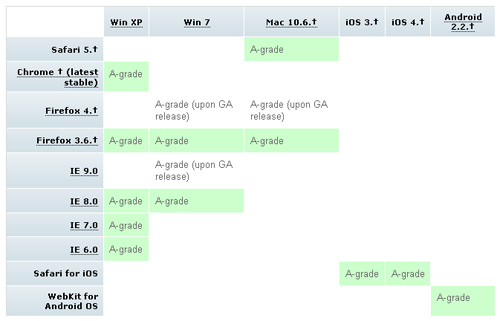
Yahoo! Developer Network (YDN) has a very interesting article on YUI Graded Browser Support. FYI, YUI stands for Yahoo! User Interface, a set of free utilities and controls that could be used in interactive web applications. As web developers, we would love to know what browsers should we put our testing on our web applications before it goes into into market. This article is the support reference for YUI projects, but also a great resource for us to know about which browsers may have significant market share.
As said in this article, before we go into the definition of the grades, it’s great to know about some characteristics of browsers:
Identified vs. Unknown There are over 10,000 browser brands, versions, and configurations and that number is growing. It is possible to group known browsers together.
Capable vs. Incapable No two browsers have an identical implementation. However, it is possible to group browsers according to their support for most web standards.
Modern vs. Antiquated As newer browser versions are released, the relevancy of earlier versions decreases.
Common vs. Rare There are thousands of browsers in use, but only a few dozen are widely used.
In this article, three grades of support are given: C-grade, A-grade and X-grade. C-grade is the base level of support, such as semantic HTML; A-grade browsers provides advanced functionality and takes full advantages of the modern web standards; X-grade is for unknown (probably brand new) browsers, they are assumed to be capable and modern.
As you may see from the graph above, the most famous browsers (with current versions), such as IE, Firefox, Chrome and Safari are listed as A-grade. However, A-grade does not mean that a user could get the same visual fidelity in all of them – it only gives us an idea that we should pay more attention on cross-browser testing on them. Interestingly, a lot of developers gradually abandon IE6, although it got an “A-grade”. IE6 was released about a decade ago and its market share has decreased dramatically these years. Moreover, it doesn’t have good support for “modern features of browsers”, for example, it could not display .png image correctly. For this and similar reasons, many developers get annoyed by using various hack tricks to ensure their application to work in different IE versions and other famous browsers.
Two IE tester tools that could be useful for cross-browser capability: